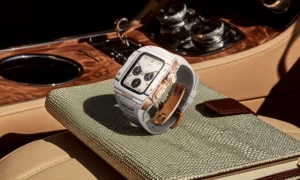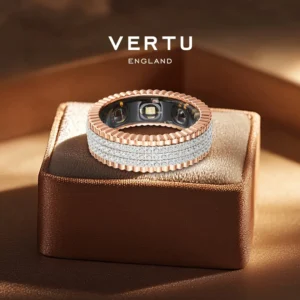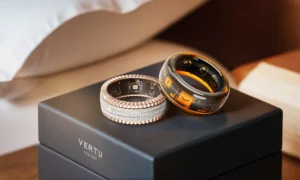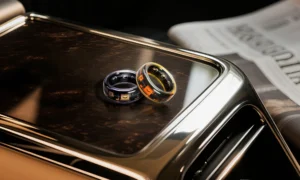
Luxury watch craftsmanship represents the pinnacle of skill and precision. It merges time-honored traditions with innovative techniques to create stunning designs. This dedication ensures that every luxury watch is not only high-quality but also stylish, transforming it into a coveted item.
People around the globe have a deep appreciation for luxury watches.
-
In 2023, the market was valued at approximately $40 billion, reflecting a 5% increase from 2022.
-
By 2033, experts predict it will expand to $80.3 billion, with an annual growth rate of 5.7%.
-
Quartz and mechanical watches are expected to dominate, accounting for 66% of the market in 2024.
Quartz and mechanical luxury watches will continue to be the most sought-after, comprising about 66% of the market in 2024.
This significant growth underscores how meticulous design and traditional craftsmanship captivate enthusiasts worldwide.
Key Takeaways
-
Luxury watches mix old techniques with new technology. They look amazing and work well too.
-
Top materials like gold, platinum, and sapphire glass make them strong and beautiful. This also makes them worth a lot.
-
Expert watchmakers carefully put them together by hand. This makes every watch special and detailed.
-
Strict tests make sure luxury watches stay accurate and work in tough conditions. They are very dependable.
-
Learning how luxury watches are made helps you admire their beauty and the hard work behind them.
The Art of Design in Luxury Watchmaking
Aesthetic and Functional Harmony
Luxury watches balance beauty and usefulness. Each part has a purpose. Some parts make the watch look better, while others improve how it works. This mix of art and science makes luxury watch design special. Famous watches show this balance clearly.
-
The Patek Philippe Nautilus is simple yet elegant. It looks great and works perfectly.
-
The Cartier Santos was one of the first wristwatches made for everyday use. It combines smart engineering with timeless style.
-
The Audemars Piguet Royal Oak changed watch design by mixing unique looks with top performance.
These watches prove that luxury watchmaking is more than just telling time. It turns watches into art, where every detail matters for both style and function.
From Hand-Sketching to Digital Precision
Luxury watch design starts with creative ideas. Designers often draw their first ideas by hand. This lets them focus on details and be creative. But modern tools have made watch design even better.
Today, digital tools help designers make perfect 3D models. These tools ensure every part fits right. Mistakes are fewer, and work is faster. For example, the VERTU GRAND WATCH-Bespoke Gold shows how technology and tradition work together. Its stylish shape looks like Swiss watches, while its advanced features, like a powerful GPU, show how art and tech combine.
By using old and new methods, watchmakers create amazing designs. This mix makes each watch both useful and beautiful.
Premium Materials in Luxury Timepieces
The Role of Precious Metals and Alloys
Luxury watches use special metals to make them unique and strong. These materials not only look great but also last a long time. Gold, platinum, and titanium are popular choices for high-end watches. Each one adds something special. Gold gives a classic, elegant look. Platinum is shiny, heavy, and feels fancy. Titanium is strong but light, making it comfortable to wear.
Some brands try new eco-friendly materials to stand out. Chopard’s Lucent Steel is tougher than regular steel and safe for sensitive skin. It’s also better for the environment. Chopard uses only responsibly sourced gold, showing they care about sustainability. These choices make luxury watches more valuable and appealing.
Rare metals are also used for limited-edition watches. One brand made a watch case from platinum to show its rarity. This made the watch highly collectible and very desirable. The materials chosen can make a watch even more special.
Sapphire Crystal and Gemstone Integration
Sapphire crystal is a key feature in luxury watches. It’s very hard, ranking 9 on the Mohs scale, so it resists scratches. This material protects the watch face and adds a shiny, clear look. Many top brands, like Cartier, use sapphire crystal to show quality and durability.
Gemstones make luxury watches even fancier. Diamonds, rubies, and sapphires are often added for extra beauty. Cartier, for example, often includes a blue sapphire on its watches. This detail shows the brand’s focus on quality and design. The gemstones are carefully chosen and placed to match the watch’s style without affecting how it works.
Together, sapphire crystal and gemstones make watches both beautiful and tough. They show the skill and care that go into making luxury watches, ensuring each one is stunning and long-lasting.
Traditional and Modern Manufacturing Techniques
Handcrafting Methods in Luxury Watchmaking
Luxury watches are made with great care by hand. Skilled workers shape, polish, and put together parts with precision. Their hard work ensures each watch is of the best quality.
Handcrafting focuses on unique designs and keeping old techniques alive. For example, engraving or guilloché patterns need steady hands and lots of practice. These methods make luxury watches special, turning them into art instead of just tools.
Some brands mix old and new ideas. Panerai uses Eco-Titanium, made from recycled metals, to help the environment. This is different from using regular mined metals. It shows how watchmaking can change while respecting its history. These methods honor traditions and embrace new ideas in luxury watchmaking.
Precision Engineering with Advanced Tools
Modern tools help make luxury watches with amazing accuracy. These tools ensure every part fits perfectly, making watches both beautiful and reliable.
Fast machines save time and improve production. CNC machines create tiny parts with extreme accuracy, down to a few microns. This precision is key for making durable and high-performing watches. Automated checks make sure all parts meet exact standards, improving quality.
Special software helps designers create complex shapes easily. This boosts creativity and speeds up work. 3D printing allows quick testing and custom designs, changing how watches are made. Brands like Christophe Claret use robots for tricky tasks but still value human skill. Combining old methods with new tools keeps luxury watchmaking innovative and authentic.
|
Feature |
Advantage |
|---|---|
|
Advanced software integration |
Helps designers make complex shapes easily, boosting creativity and speed. |
|
High-speed machining processes |
Saves time and improves production efficiency. |
|
Tight tolerances |
Makes parts with extreme accuracy, ensuring great performance. |
|
Automated inspection systems |
Checks parts carefully, reducing mistakes and improving quality. |
Precision tools make luxury watches more dependable and stunning. These advancements show how watchmaking blends art and technology to create amazing timepieces.
Assembly and Adjustment by Master Watchmakers
The Skill of Hand Assembly
Master watchmakers are key to building luxury watches. Their skills make sure every part fits just right. This creates watches that work well and look amazing. Famous watchmakers like George Daniels and Derek Pratt are known for their great work. Daniels made parts by hand and created unique designs, like his Grand Complication. This watch had features like a calendar and a minute repeater, showing top-level craftsmanship. Pratt brought back the Urban Jürgensen brand by using old machines to make delicate parts. Both show how important skilled hands are in making excellent watches.
Hand assembly is more than putting pieces together. It requires careful attention to every detail. Each part must fit perfectly. This process turns a watch into a symbol of luxury and precision. The VERTU GRAND WATCH-Bespoke Gold is a great example. Its detailed design and modern features show how tradition and technology can work together. Wearing such a watch means carrying a piece of art made by expert hands.
Adjusting for Accuracy and Performance
After assembly, luxury watches are adjusted to keep perfect time. This step makes sure the watch works well in different situations. Accuracy is checked by how many seconds a watch gains or loses daily. For example:
-
Many high-end watches allow a change of –4/+6 seconds per day.
-
Only 3% of Swiss watches earn COSC certification, proving this level of accuracy.
-
Some watches, like Grand Seiko's Caliber 9S, are even better with –3/+5 seconds limits.
Historian David S. Landes said, “A watch’s quality depends on its precision.”
Adjustments are made to parts like the balance wheel and escapement. These changes help the watch stay accurate and work well for years. The VERTU GRAND WATCH-Bespoke Gold shows how fine-tuning makes a watch both reliable and artistic. Its strong materials and advanced features turn it into a true masterpiece.
Decorative Techniques in Luxury Watch Craftsmanship
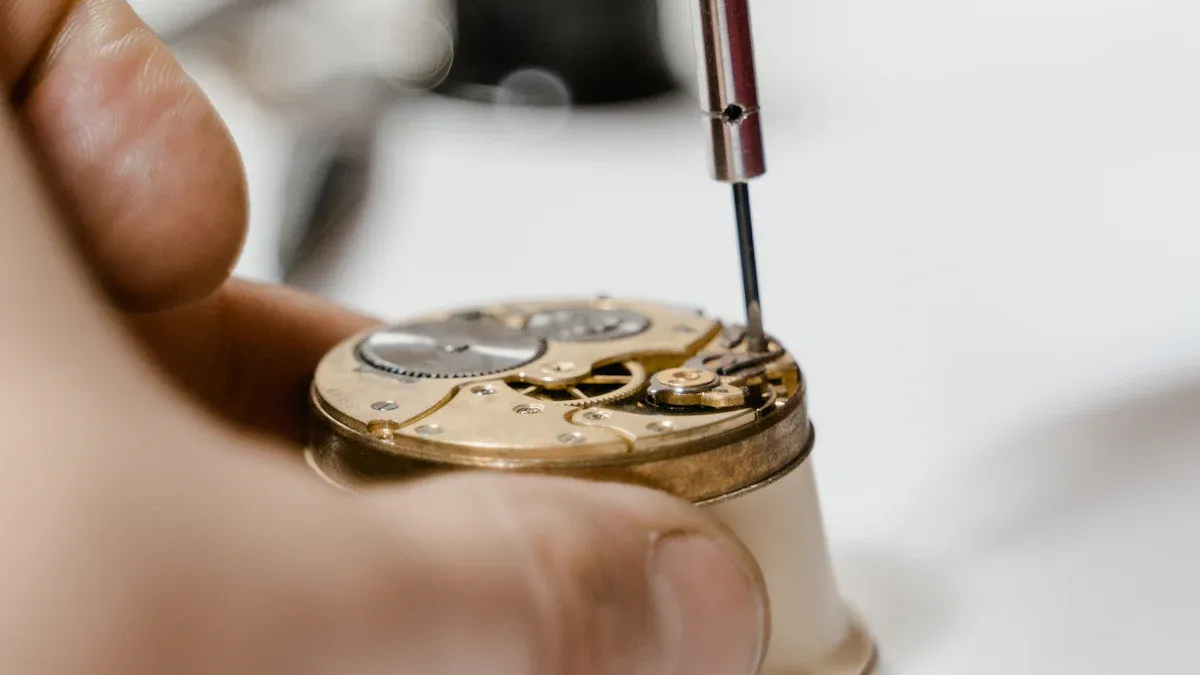
Hand Engraving and Guilloché Patterns
Hand engraving and guilloché patterns show the skill of watchmakers. These methods turn watch faces into detailed designs, making each one unique. Only experts can create these special touches by hand.
-
The textured surface stops glare, helping you see clearly.
-
These designs hide small flaws, making the dial look perfect.
-
Craftsmen show their skill with even spacing and depth.
-
Tiny differences in hand engraving add a personal feel.
-
Real guilloché work looks 3D, unlike flat copies, showing true luxury.
The VERTU GRAND WATCH-Bespoke Gold is a great example. Its Fortune Flame Pattern on the base symbolizes peace and luck. Wearing this watch means carrying a story made by skilled hands.
Polishing and Finishing for Elegance
Polishing and finishing make luxury watches shiny and stylish. These steps need careful work to make every surface look amazing.
One famous method is Zaratsu polishing, which creates a mirror-like shine. It takes years to learn this skill. The result is a surface that reflects light beautifully. When paired with brushed textures, it adds depth to the design. These techniques highlight the watch’s details, making it a true work of art.
The VERTU GRAND WATCH-Bespoke Gold shows how finishing adds beauty. Its sapphire mirror is tough and shiny, with a Grade 9 Mohs hardness. This careful work shows the dedication of luxury watchmakers. Choosing this watch means enjoying both style and expert craftsmanship that lasts.
Rigorous Quality Testing for Luxury Watches
Strength and Water Resistance Checks
Luxury watches go through tough tests to ensure top quality. These tests make sure the watch stays strong and works well in different situations. Makers use special methods to check strength and water resistance.
|
Test Type |
What It Does |
|---|---|
|
Watches face water pressure to match their depth rating. |
|
|
Temperature Check |
Seals are tested in hot and cold to keep water out. |
|
Submersion Check |
Watches are placed underwater for a set time to test leaks. |
|
Performance Check |
Dive watches are tested for accuracy and function after water tests. |
These tests prove the watch can handle daily use and tough conditions. Certifications like METAS and Master Chronometer confirm their durability. For example, METAS checks water and magnetic resistance to ensure the watch works well in real life. By passing these tests, luxury watches give you trust and long-lasting performance.
Checking Accuracy and Performance
Luxury watches are known for being very precise. Careful testing ensures they keep perfect time and work smoothly. Certifications like Master Chronometer and Superlative Chronometer show the highest level of accuracy.
Master Chronometer certification includes eight tests, such as checking time accuracy, power reserve, and magnetic resistance up to 15,000 gauss. These tests mimic real-life situations to make sure the watch works perfectly. Rolex’s Superlative Chronometer certification tests watches in extreme heat and humidity to ensure they stay accurate in all conditions.
Only 3% of Swiss watches earn COSC certification, showing their rare precision.
These certifications go beyond normal standards, giving you a watch that blends art and technology. Wearing a luxury watch like the VERTU GRAND WATCH-Bespoke Gold means enjoying a piece that has passed strict tests, offering both beauty and reliability.
Luxury watchmaking mixes old traditions with new ideas. Every step, from design to assembly, combines beauty and usefulness. Swiss watchmakers have shared their skills for many years. Famous brands like Rolex and Patek Philippe show this history. They also use modern features like quartz movements and tourbillons. These updates make watches both stylish and high-performing. Learning about these methods helps you see the care and talent behind these amazing creations.
FAQ
What makes luxury watches special compared to regular ones?
Luxury watches use high-quality materials like gold and sapphire. They have detailed designs and are made with expert skill. These watches also go through tough tests to ensure they last and work well.
How do watchmakers make sure luxury watches are accurate?
Watchmakers adjust parts like the balance wheel to keep time right. They test the watches in different conditions to check their accuracy. Certifications like COSC and Master Chronometer prove they meet top standards.
Why is sapphire crystal important in luxury watches?
Sapphire crystal is very hard and resists scratches. It protects the watch face and gives it a shiny, clear look. This material makes the watch strong and more attractive.
How do gemstones make luxury watches better?
Gemstones like diamonds and sapphires make watches look fancy. Watchmakers carefully add these stones to match the design. They make the watch beautiful without affecting how it works.
Why is handcrafting important in making luxury watches?
Handcrafting keeps old skills alive and focuses on details. Skilled workers create special designs like engraving and patterns. This makes each watch a unique piece of art.

